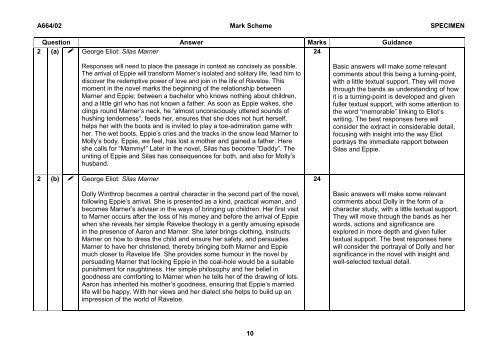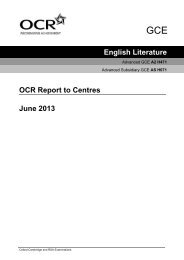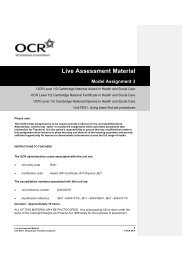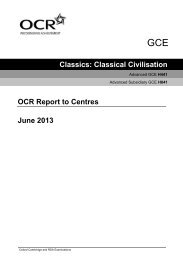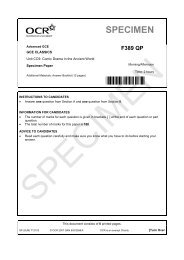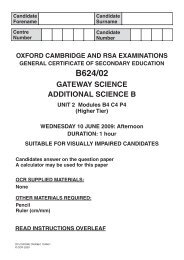Higher - From September 2013 - Specimen - OCR
Higher - From September 2013 - Specimen - OCR
Higher - From September 2013 - Specimen - OCR
Create successful ePaper yourself
Turn your PDF publications into a flip-book with our unique Google optimized e-Paper software.
A664/02 Mark Scheme SPECIMEN<br />
Question Answer Marks Guidance<br />
2 (a) George Eliot: Silas Marner<br />
24<br />
Responses will need to place the passage in context as concisely as possible.<br />
The arrival of Eppie will transform Marner’s isolated and solitary life, lead him to<br />
discover the redemptive power of love and join in the life of Raveloe. This<br />
moment in the novel marks the beginning of the relationship between<br />
Marner and Eppie; between a bachelor who knows nothing about children,<br />
and a little girl who has not known a father. As soon as Eppie wakes, she<br />
clings round Marner’s neck, he “almost unconsciously uttered sounds of<br />
hushing tenderness”, feeds her, ensures that she does not hurt herself,<br />
helps her with the boots and is invited to play a toe-admiration game with<br />
her. The wet boots, Eppie’s cries and the tracks in the snow lead Marner to<br />
Molly’s body. Eppie, we feel, has lost a mother and gained a father. Here<br />
she calls for “Mammy!” Later in the novel, Silas has become “Daddy”. The<br />
uniting of Eppie and Silas has consequences for both, and also for Molly’s<br />
husband.<br />
Basic answers will make some relevant<br />
comments about this being a turning-point,<br />
with a little textual support. They will move<br />
through the bands as understanding of how<br />
it is a turning-point is developed and given<br />
fuller textual support, with some attention to<br />
the word “memorable” linking to Eliot’s<br />
writing. The best responses here will<br />
consider the extract in considerable detail,<br />
focusing with insight into the way Eliot<br />
portrays the immediate rapport between<br />
Silas and Eppie.<br />
2 (b) George Eliot: Silas Marner<br />
24<br />
Dolly Winthrop becomes a central character in the second part of the novel,<br />
following Eppie’s arrival. She is presented as a kind, practical woman, and<br />
becomes Marner’s adviser in the ways of bringing up children. Her first visit<br />
to Marner occurs after the loss of his money and before the arrival of Eppie<br />
when she reveals her simple Raveloe theology in a gently amusing episode<br />
in the presence of Aaron and Marner. She later brings clothing, instructs<br />
Marner on how to dress the child and ensure her safety, and persuades<br />
Marner to have her christened, thereby bringing both Marner and Eppie<br />
much closer to Raveloe life. She provides some humour in the novel by<br />
persuading Marner that locking Eppie in the coal-hole would be a suitable<br />
punishment for naughtiness. Her simple philosophy and her belief in<br />
goodness are comforting to Marner when he tells her of the drawing of lots.<br />
Aaron has inherited his mother’s goodness, ensuring that Eppie’s married<br />
life will be happy. With her views and her dialect she helps to build up an<br />
impression of the world of Raveloe.<br />
Basic answers will make some relevant<br />
comments about Dolly in the form of a<br />
character study, with a little textual support.<br />
They will move through the bands as her<br />
words, actions and significance are<br />
explored in more depth and given fuller<br />
textual support. The best responses here<br />
will consider the portrayal of Dolly and her<br />
significance in the novel with insight and<br />
well-selected textual detail.<br />
10


